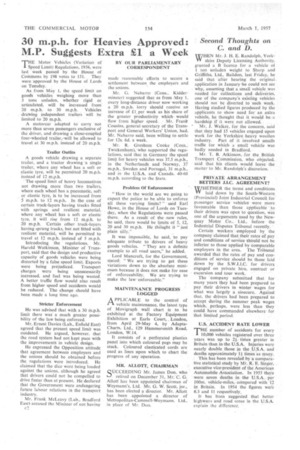30 nri.p.h. for Heavies Approved: M.P. Suggests Extra £1 a Week
Page 44

If you've noticed an error in this article please click here to report it so we can fix it.
BY OUR PARLIAMENTARY CORRESPONDENT •
THE Motor Vehicles (Variation of Speed Limit) Regulations, 1956, were last Week passed by the House of Commons by 198 votes to 151. They were approved by the House of Lords on Tuesday.
As from May 1, the speed limit on goods vehicles weighing more than 3 tons unladen, whether rigid or articulated, will be increased from 20 m.p.h. to 30 m.p.h. Vehicles drawing independent trailer's will be limited to 20 m.p.h, A motorcar adapted to carry not more than seven passengers exclusive of the driver, and drawing a close-coupled four-wheeled trailer, will be allowed to travel at 30 m.p.h, instead of 20 m.p.h.
Trailer Outfits A goods vehicle drawing a separate trailer, and a tractor drawing a single trailer, where any wheel has a soft or elastic tyre, will be permitted 20 m.p.h. instead of 12 m.p.h.
• The speed limit of heavy locomotives not drawing more than two trailers, where each wheel has a pneumatic, soft or elastic tyre, is to be increased from 5 m.p.h. to 12 m.p.h. In the case of certain track-layers having tracks fitted with springs and resilient material. where any wheel has a soft or elastic tyre, it will rise from 12 m.p.h. to 20 m.p.h. 'Certain other track-layers having sprung tracks, but not fitted with resilient material, will be permitted to travel at 12 m.p.h. instead of 5 m.p.h.
Introducing the regulations. Mr. Harold Watkinson, Minister of Transport, said that the design and productive capacity of goods vehicles were being distorted by a false speed limit. Exports were being prejudiced. Transport charges were being unnecessarily increased, and fuel was being wasted. A better traffic flow would also result from higher speed and accidents would he reduced. The change should have been made a long time ago.
Stricter Enforcement He was advised that with a 30 M.p.h. limit there was a much greater possibility of the law being enforced.
Mr. Ernest Davies (Lab., Enfield East) agreed that the present speed limit was outdated. He argued, however, that the road system had not kept pace with the improvements in vehicle design.
He expressed the Opposition attitude that agreement between employers and the unions should be obtained before the regulations were introduced. He claimed that the dice were being loaded against the unions, although he agreed that drivers could not be compelled to drive faster than at present. He declared that the Government were endangering future labour relations in the transport industry.
Mr. Frank McLeavy (Lab., Bradford East) accused the Minister of not having c2
made reasonable efforts to secure a settlement between the employers and the unions.
Mr. G. Nabarro (Cons., Kidderminster) suggested that as from May I, every long-distance driver now -working a 20 m.p.h. lorry should receive an increase of E1. per week as his share of the greater productivity which. would
flow from higher Speed. Mr. Frank Cousins, general -secretary of the Transport and General Workers' Union, had. Mr. Nabarro said, been willing to settle for 12s. 6d. a week.
Mr. R. Gresham Cooke (Cons., Twickenham), 'who supported the regulations, said that in Germany the speed limi,t for heavy vehicles was 37.5 m.p.h., in the Netherlands and Norway, 37 m.p.h,, Sweden and Portugal, 31 m.p.h., and in the U.S.A. and Canada, 40-60 m.p.h. according to the State.
Problem Of Enforcement
"How in the world are we going to expect the police to be able to enforce all these varying limits? " said Earl Howe, in the House of Lords on Tuesday, when the Regulations were passed there. As a result of the • new rules, he said, there would be limits of 5, 12, 20 and 30 m.p.h. He th-olight it "just plain silly."
It was impossible, he said, to pay adequate tribute to drivers of heavy goods vehicles. "They are a definite example to all road users," he added. Lord Mancroft, for the Government, stated: "We are trying to get these variations down to the absolute minimum because it does not make for ease of enforceability. We are trying to make the law • enforceable."
MAINTENANCE PROGRESS LOGGED
A PPLICABLE to the control of rA, vehicle maintenance, the latest type of Movigraph wall chart is to be exhibited at the Factory Equipment Exhibition at Earls Court— London, from April 29-May 4, by AdaptaCharts, Ltd., 129 Hammersmith Road. London, W.14.
It consists of a perforated plastics panel into which coloured pegs may be stuck. Coloured elasticated cords are used as lines upon which to chart the progress of any operation.
MR. ALLO'TT, CHAIRMAN
SUCCEEDING Mr. James Don, who retired on December 31, Mr: C. G. Allott has been appointed chairman of Weymann's, Ltd. Mr. G. W. Scott, jr., has been elected a director. Mr. Allott has been appointed a director of Metropolitan-Cammell-Weymann. Ltd., in place of Mr. Don.












































































































